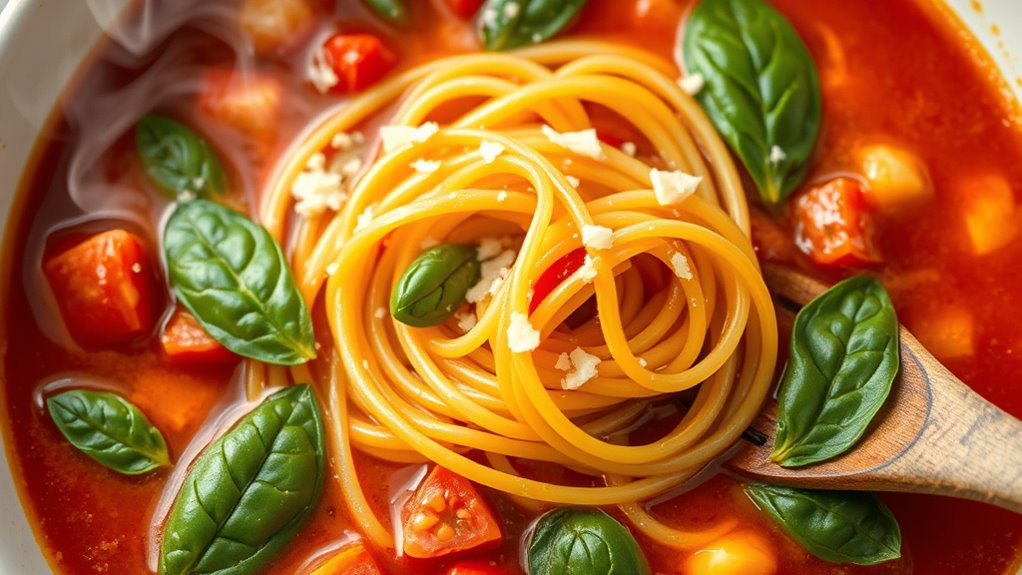Craving a cozy, one-pot meal? Sauté garlic in olive oil until it perfumes the room, then pour in a simmering broth kissed with tomatoes. Toss in al dente spaghetti and let it soak up the flavors, its strands winding through the fragrant steam. A pinch of red pepper, a dusting of cheese, and a fresh crack of pepper finish with brightness. Serve hot with crusty bread, and discover more tasty twists just beyond this whisk of comfort.
Ingredients and Quantity
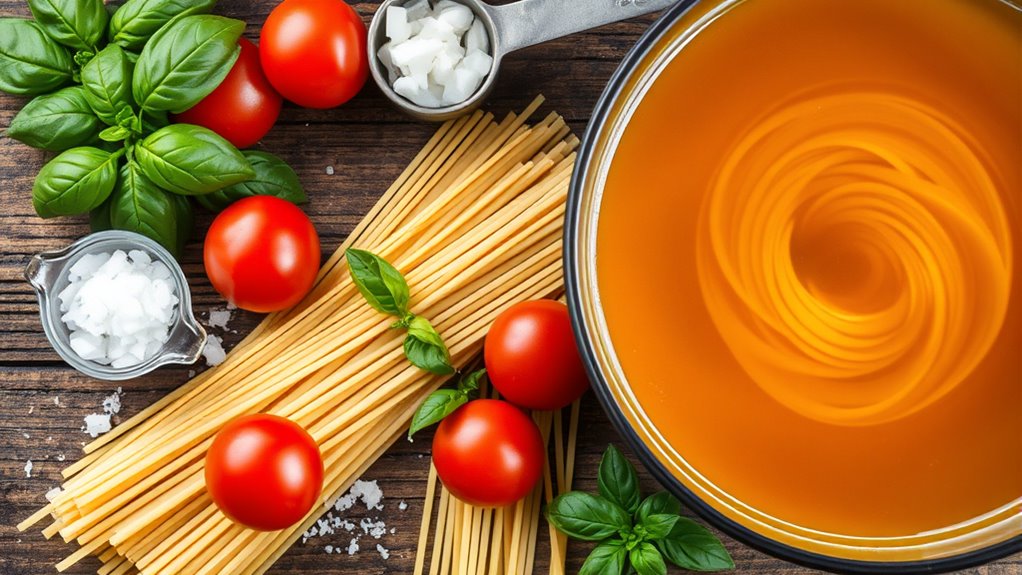
Here are the ingredients you’ll need, measured for two servings: 8 ounces spaghetti, 2 cups chicken or vegetable broth, 1 cup tomatoes (fresh or crushed), 2 cloves garlic, 1 tablespoon olive oil, 1/2 teaspoon salt, 1/4 teaspoon black pepper, and a pinch of red pepper flakes if you like a little heat. You’ll taste freedom in each bite as you choose your soup bases and explore a spectrum of spaghetti varieties. The broth becomes a warm stage, tomatoes offer brightness, garlic provides bite, and olive oil glides in silky. Visuals accompany flavor ideas below to spark your kitchen improvisation.
| Idea A | Idea B |
|---|---|
| Spaghetti varieties | Soup bases |
| Fresh tomatoes | Broth blends |
| Garlic aroma | Heat balance |
| Olive oil sheen | Salt and pepper |
| Red pepper touch | Texture contrast |
Preparations
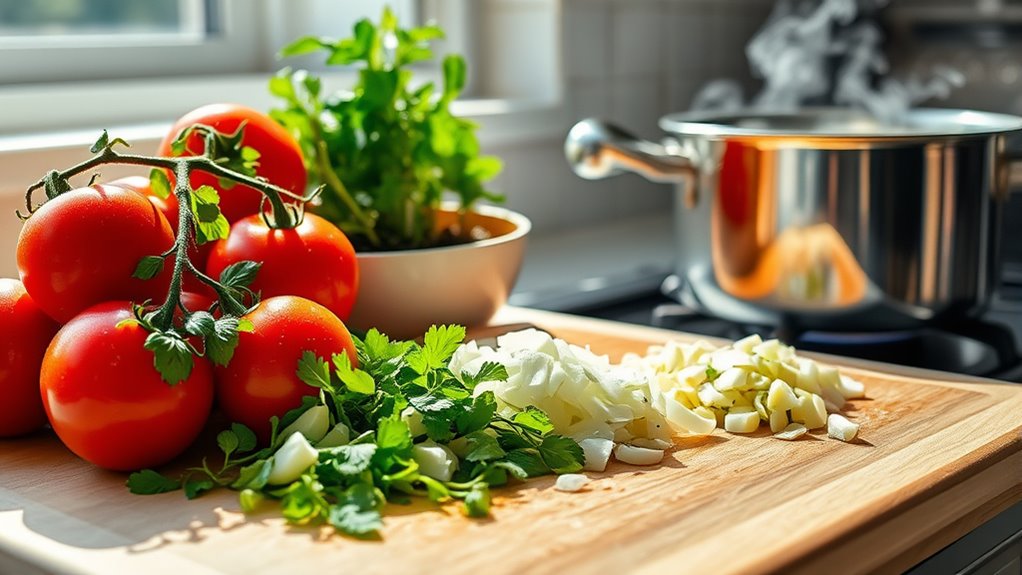
As you prep, a quick rhythm settles in: boil the broth to a gentle simmer, so your flavors can mingle without rushing. You’ll rinse fresh ingredients and measure seasonings with calm intention, letting textures guide you. Slice vegetables into bite-sized notes, so they sing at the same tempo as the pasta. Stir gently, watching bubbles rise like tiny ideas. Consider spaghetti variations as you choose pasta shapes, noting how thickness and curl affect bite. Taste a spoonful of broth and adjust salt, pepper, and herbs, keeping a light hand for balance. In your mind, map the soup types you’ll craft later, from brothy to creamy, and keep this prep focused, precise, and liberated in flavor.
Kitchen tools or Kitchenware Required
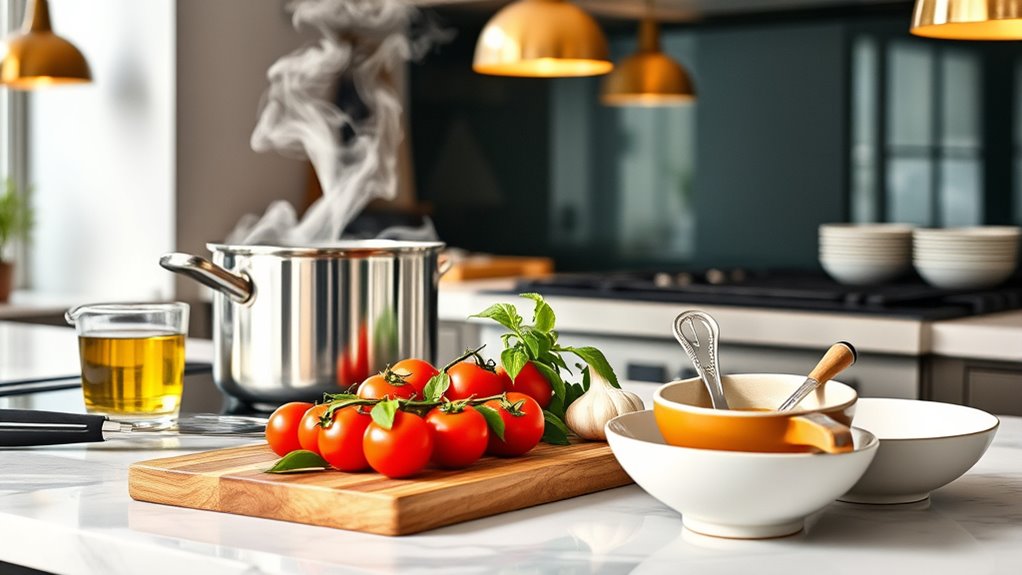
To make this spaghetti soup sing, you’ll want a few reliable tools within easy reach: a sturdy medium pot for the broth, a wide skillet for sautéing aromatics, and a ladle to lift warmth with ease.
Kitchen tools list
| Tool | Purpose |
|---|---|
| Measuring cups | portion control, precision |
| Cooking pots | simmering both stock and pasta |
| Slotted spoon | lift and drain vegetables |
| Wooden spoon | gentle stirring without scratching |
| Whisk | emulsify and blend flavors |
You crave freedom in flavor, not fuss, so select trusted, simple gear that feels right in your grip. The right measuring cups guarantee accuracy, while sturdy cooking pots promise even heat. Sensory satisfaction starts with the weight, texture, and quiet clink of confidence you hear as you cook.
How to Cook
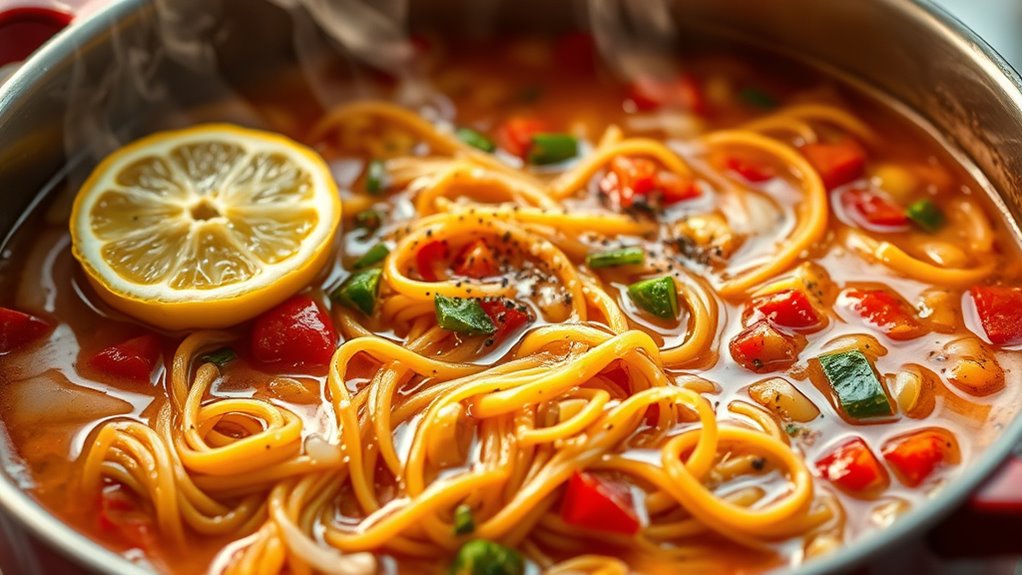
- Warm a sturdy pot over medium heat.
- Add a slick of olive oil and let it shimmer.
- Add garlic and onions, cooking until they release their aroma.
- Simmer broth gently until it breathes.
- Slide in spaghetti fragments and watch them soften.
- Stir gently and avoid rushing the process.
- Taste regularly, balancing salt with a pinch of pepper.
- Add a squeeze of lemon or a hint of chili for brightness, if desired.
- Add vegetables in stages to maintain distinct textures.
- Use light simmering, occasional stirring, and precise timing to prevent mushiness.
- Experiment with soup variations by swapping in tomatoes, herbs, or greens.
- Maintain the core spirit of simple, honest comfort food.
How to Serve
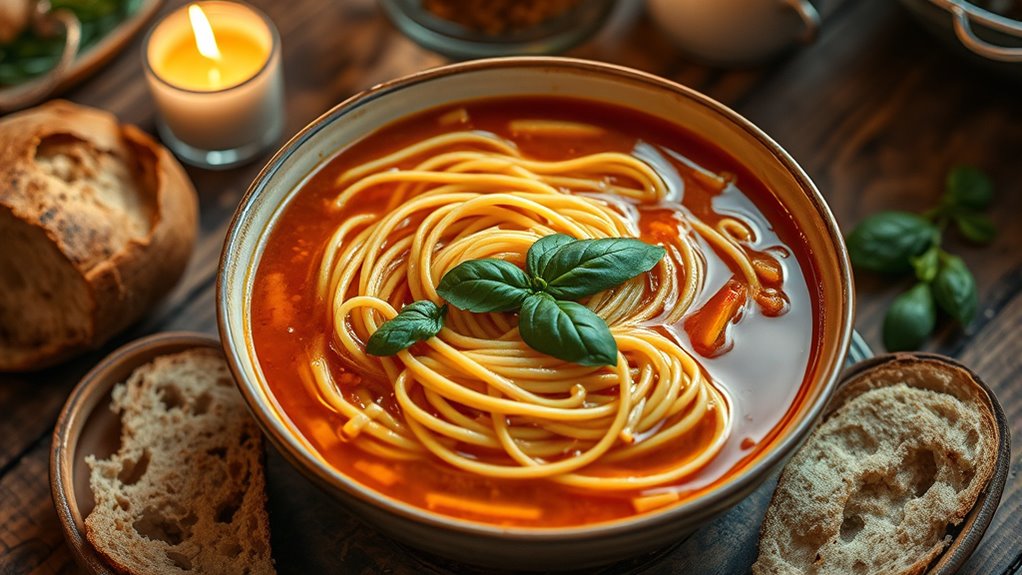
Spaghetti soup is meant to be enjoyed in its warmth, so serve it hot to savor the steam and soft noodles clinging to a fork. You guide the bowl to your table with confidence, inviting a slow inhale of garlic and basil as fragrance rises. For serving suggestions, keep portions modest, so the spoon tracks through the broth without spill. Offer a crusty bread as a practical companion, not mere ornament. Garnishing options include a drizzle of olive oil, a pinch of red pepper, and a scatter of grated cheese, each element adding texture and resonance. Plate with care, letting heat surprise your senses. You choose pace, savor, and the simple joy of a shared, unhurried meal.
Tips
Tuck your ingredients close and prep with a calm rhythm, because great spaghetti soup starts long before the pot hits the flame. You’ll savor the quiet clarity of mise en place, every jar labeled, every herb measured. Tip by tip, let the kitchen breathe: sauté aromatics until they wink with scent, then bloom stock into the pot so flavors wake gradually. Trust your senses as you adjust salt and pepper, tasting as you go. For cooking techniques, keep the heat steady and the spoon moving, avoiding harsh boils. For flavor enhancements, finish with a drizzle of olive oil, a squeeze of citrus, or a handful of fresh parsley to lift brightness. Line your steps with intention, and your soup will sing.
Food Value and Benefit
When you enjoy a warm bowl of spaghetti soup, you’re not just having a comforting meal—you’re nourishing your body with a blend of essential nutrients. This dish provides a good source of protein and dietary fiber, supporting muscle repair and digestive health. The tomatoes contribute vitamin C and potassium, which help maintain heart health and regulate blood pressure. Garlic and herbs add antioxidants and anti-inflammatory compounds, promoting immune function and overall well-being. The soft pasta offers complex carbohydrates for slow-release energy, helping to sustain focus and mobility throughout the day.
Benefits of eating this recipe include:
- Mobility-friendly comfort supporting ease of movement
- Steady energy release for prolonged mental and physical stamina
- Digestive support through fiber and natural digestive aids
- Heart-friendly nutrients such as potassium and antioxidants
- Mood-boosting flavors rich in vitamins and minerals
Vitamins and minerals in this recipe:
- Vitamin C (from tomatoes and herbs)
- Potassium (from tomatoes)
- Iron (from garlic and herbs)
- B Vitamins (from pasta)
- Antioxidants (from garlic and herbs)
Frequently Asked Questions
Can I Use Gluten-Free Pasta in This Soup?
Yes, you can; gluten-free options work wonderfully here. You’ll savor tender bites and cozy aromas, while creamy broth glides past your lips. Try pasta alternatives for texture, then celebrate liberar choice, embracing gluten free options in comfort.
What if I Don’T Have Fresh Herbs?
Substitute options glow softly: dried herbs can stand in for fresh if you’re out. You’ll savor a cozy aroma, and you’ll improvise confidently, adjusting salt. If needed, add lemon zest for bright, freeing, lingering notes.
How Long Can Leftovers Safely Be Stored?
Leftovers stay safe for about 3 to 4 days in the fridge; if you’re unsure, trust your senses. For longer peace of mind, freeze soup storage and label dates, because leftover safety matters to your freedom.
Can I Freeze the Soup for Later?
Yes, you can freeze the soup for later. You’ll savor the fresh, icy hush as flavors tighten, using proper freezing techniques and sturdy soup containers that seal softly, preserving scent, texture, and freedom from freezer burn.
Is Dairy-Free Cheese an Acceptable Substitute?
Yes, you can. Dairy-free cheese can substitute, though texture shifts and flavor effort vary. You’ll savor dairy free alternatives, embracing cheese flavor with bold, bright batter-balance, while freedom-loving foodies frame fabulous, flavorful, funky, fragrant finishing touches.
